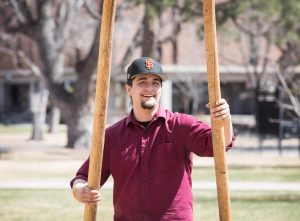CC’s Indigenous and Native Community Pushes for Policy Change, and More
Cristina Garcia ’19 is on the move. After receiving her diploma in May with a double major in Southwest Studies and Religion and an Indigenous Studies minor, she headed to Tulsa, Oklahoma, for six weeks of training with Teach for America. This fall, her TFA placement will send her to Chávez Huerta K-12 Preparatory Academy in Pueblo, Colorado.
No matter how far from CC she roams, though, Garcia will always be known as one of the students who helped to change campus policy for indigenous and native peoples.
Garcia’s family comes from the Southern Ute and Picuris Pueblo tribes, though she’s clear to state that she has not been able to be tribally enrolled due to colonization impacts. She identifies as indigenous, and smudging — a traditional ceremonial practice of burning herbs to create smoke for religious purposes — had always been a welcome and consistent part of her life, until she got to CC.
“My freshman year at CC, I was written up for smudging several times,” she says, and she was required to hand over some of the ritual components she was using in the privacy of her dorm room. These reprimands got attention from her indigenous peers, and, she says, became a catalyst for discussion.
“People were really upset … so from there on, the indigenous community was looking for a place that would be home where we wouldn’t be persecuted for those practices. We knew that it needed to change policy-wise because a lot of the other schools that have a lot of native students — like Arizona State University, Haskell University, a lot of different schools across the nation — have policies already put in place to protect native students. We saw that there was nothing like that at CC.”

Mateo Parsons ’19 helps students from the Native American Student Union and facilities employees put up the NASU teepee ahead of the CC Powwow.
It would take a few years, but ultimately a 14-person committee of faculty, elders, and indigenous students including Garcia and Mateo Parsons ’19, co-chairs of the Native American Student Union, did enact change. In September 2018, CC put into place the Smudging and Pipe Ceremonies Policy to allow indigenous students to perform their religious and tribal ceremonies.
Religious freedom
Until 40 years ago, Native Americans weren’t allowed under the U.S. Constitution to practice their religious or ceremonial ways. The American Indian Religious Freedom Act of 1978 changed that, stating “On and after August 11, 1978, it shall be the policy of the United States to protect and preserve for American Indians their inherent right of freedom to believe, express, and exercise the traditional religions of the American Indian, Eskimo, Aleut, and Native Hawaiians, including but not limited to access to sites, use and possession of sacred objects, and the freedom to worship through ceremonials and traditional rites.”
“It’s something that should be accepted and understood,” says Garcia, “but it’s clearly not when people are still being persecuted. And it made me think if it had been someone who was Muslim or even someone who had just identified as Catholic, if they would have been treated in that same manner.”
So why, if the AIRFA is active nationally, were CC students needing to fight for their rights on campus?
Dwanna Robertson, a member of the Muscogee Nation and an assistant professor in CC’s Race, Ethnicity and Migration Studies, told The Catalyst last fall that the policy was a direct response to a new tobacco usage policy installed in 2017.
“It has been important for us to delineate from ceremonial smoke and tobacco use in general,” Robertson said, meaning that though by the new policy the campus is a smoke- and tobacco-free space, indigenous students are allowed to use both if they are doing it in accordance with their religious practices.
Smudging 101
The how and what of smudging differs by tribe.
“There are different plants that different tribes use for smudging,” explains Garcia. Sage and sweetgrass are two that she uses and says are most common, but the choice is very individualized — as is what smudging means to each person.
“For myself, I would say that it’s a way of purifying yourself and the space around you … it’s the process of being in [my] own space and trying to … get to a healthier place of mind and a better way of being.”
Parsons agrees. “It’s a good practice, especially if you’re in an unfamiliar environment or a high-pressure environment. It’s good to keep yourself centered and to stay true to who you are and your core.”
When Garcia smudges, she likes to be by herself — when on campus, she wouldn’t typically smudge with a roommate around unless she felt super comfortable with them or had talked to them about it. Once alone, she’ll remove her smudge stick from its “home” where it rests in abalone shells and light the stick to burn the herbs and allow smoke to circulate.
“I’ll just stand up and I’ll smudge myself first because that’s really important. You can’t smudge anything else in the room before you do that for yourself. And then I’ll go ahead and smudge the space around me. I start at my feet and then I go up my body, towards my legs, towards my midpoint and then through to my arms and then to my hair and then to my back.”
Other elements may be a part of the ritual as well. Garcia notes that since she was also raised Catholic, her smudging practice includes burning incense.
“That’s definitely not something that I think any other family or tribe that I’ve heard of does. It’s just really personal to me.”
Moving forward
Neither Garcia nor Parsons may be on campus anymore, but as alumni they still have an interest in the direction CC takes regarding indigenous students.
Parsons says that Dean of Students and Vice President for Student Life Mike Edmonds has been committed to hiring a Native American and indigenous student support specialist during the next academic year, and he hopes that does happen. “The native staff and faculty who are at CC right now are amazing resources. … If we can continue recruiting native staff and faculty, as well as native students, that would definitely add to the sense of community. … One of the biggest issues, being somebody who identifies as native or indigenous at CC, is isolation. The community is so small, it’s really hard to find people who have commonalities with you.”
“I understand that they have changed so many things,” says Garcia. “Like adding Revitalizing Nations [Living and Learning housing community] was an amazing first step. Doing the smudging policy was another great first step. Tava Quad [naming], another step. But I hope people realize that by enacting these policies that they’re not trying to placate the communities, but they’re actually trying to grow with them. Trying to learn about what we need and continuing to support the students and recognizing that the students advocating for that are advocating for a reason,” she says.
“I hope that they continue to seek other indigenous people’s voices when making those kinds of decisions and that indigenous voices are always included and they always have a seat at the table,” she adds. “To recognize that it’s not just sometimes or a one-time thing. It needs to be consistent throughout different college practices.”
Smudging and Pipe Ceremonies Policy
Approval Date: September 2018
Colorado College recognizes that our institution was founded upon, and rests upon, ancient tribal lands first occupied by indigenous/Native American peoples, primarily the Ute, Cheyenne, Arapahoe, and Kiowa Nations, and other First Peoples of these lands. The college also recognizes that there are many indigenous religious ceremonies and sacred traditions practiced by indigenous/Native American peoples, including smudging and pipe ceremonies. Smudging and pipe ceremonies may incorporate the smoke of sage, sweetgrass, cedar, tobacco, and other related medicinal plants as elements of purification and sacred ceremony.
Colorado College has designated venues on campus for indigenous/Native American students, faculty, staff, and guests to practice smudging and/or pipe ceremonies associated with traditional religious ceremonies and observances. Additionally, the college recognizes and supports indigenous/Native American students engaging in these sacred practices within the privacy of their residence hall rooms.
The purpose of this policy: To protect, promote, and facilitate indigenous/Native American students, faculty, staff, and visitors practicing indigenous/Native American religious traditions and ceremonies, including smudging and pipe ceremonies, and to do so in harmony with established college smoke and fire policies.


One Response to Sacred Smoke
I am so elated to see this beautiful development at CC. My hat off to NASU’s advocacy, to Garcia and Parsons, and to the committee that put this policy forward. This sounds inclusive, responsive, and healing. Thank you!
Comments are closed.